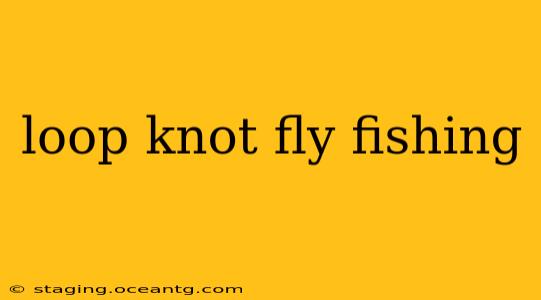The loop knot has revolutionized fly fishing, offering anglers a superior connection between fly line and leader. Its streamlined design minimizes friction, leading to improved casting distance and accuracy. This comprehensive guide will delve into the intricacies of tying the loop knot, addressing common questions and providing expert tips for flawless execution. Whether you're a seasoned angler looking to refine your technique or a beginner eager to learn, this guide will equip you with the knowledge to master this essential knot.
What is a Loop Knot in Fly Fishing?
A loop knot in fly fishing is a type of connection knot that creates a loop at the end of your fly line, allowing you to seamlessly attach your leader. Unlike traditional methods that involve direct connection, the loop knot eliminates bulk and friction, resulting in smoother casts and better presentation of your fly. Several variations exist, but the most popular and reliable remains the perfection loop knot.
Why Use a Loop Knot for Fly Fishing?
The benefits of employing a loop knot are numerous and significantly enhance the overall fly fishing experience:
- Improved Casting Distance: The reduced friction from a streamlined connection translates to longer casts, allowing you to reach those distant feeding fish.
- Increased Accuracy: The smooth transition between line and leader leads to greater accuracy in placing your fly precisely where you intend.
- Easier Line Management: The loop facilitates quicker and smoother line changes, making it easier to adapt to changing fishing conditions.
- Reduced Tangles: The streamlined design minimizes the chances of line tangles, improving overall efficiency on the water.
- Stronger Connection: When tied correctly, a loop knot provides a remarkably strong connection, capable of withstanding the force of powerful fish.
How to Tie a Perfection Loop Knot: A Step-by-Step Guide
While various loop knots exist, the perfection loop is widely considered the most reliable and easiest to master. Here's a step-by-step guide:
- Form the Loop: Create a loop in your fly line approximately the length of your leader.
- Double Over: Pass the running end of the fly line over the loop twice.
- Pass Through the Loop: Thread the running end through the loop created by the double over.
- Tighten: Gently tighten the loop by pulling on the standing end of the fly line.
- Inspect and Adjust: Carefully inspect the knot, ensuring it is securely tied and the loop is smooth and even.
(Note: Visual aids, such as videos found online, are highly recommended for a clear understanding of the steps.)
What are the Different Types of Loop Knots?
While the perfection loop reigns supreme, other loop knots exist, each with its own nuances:
- The Albright Knot: A strong and reliable option, though slightly more complex to tie than the perfection loop.
- The Surgeon's Knot: Often used for connecting two pieces of line of similar diameter, but not ideally suited for connecting fly line and leader.
How Tight Should a Loop Knot Be?
The loop knot should be snug but not overly tight. Over-tightening can weaken the knot and potentially lead to breakage. The ideal tightness allows for a smooth, unimpeded flow of line during casting.
How Long Should My Loop Be?
The ideal loop length is generally equivalent to the length of your leader. Experimentation might be needed to find the perfect length that suits your casting style and the conditions.
How Do I Attach My Leader to the Loop?
Attaching the leader to the loop is straightforward. Simply pass the leader's end through the loop and cinch it tight.
Troubleshooting Common Loop Knot Problems
- Knot Slips: Ensure the knot is correctly tied and properly tightened. Using a knot-tying tool can improve consistency and prevent slippage.
- Weak Knot: This usually results from improper tying or over-tightening. Practice until you master the technique.
- Knots Too Large: Adjust the loop length to ensure the loop is the appropriate size.
Mastering the loop knot is a crucial skill for any fly fisher. By following this guide and practicing diligently, you'll enhance your casting abilities and elevate your fly fishing game to a whole new level. Remember to consult visual aids and experiment to discover what works best for you. Happy fishing!
